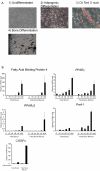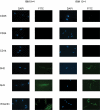Human fetal mesenchymal stem cells differentiate into brown and white adipocytes: a role for ERRalpha in human UCP1 expression
- PMID: 20101261
- PMCID: PMC2848839
- DOI: 10.1038/cr.2010.11
Human fetal mesenchymal stem cells differentiate into brown and white adipocytes: a role for ERRalpha in human UCP1 expression
Abstract
We investigated the ability of fetal mesenchymal stem cells (fMSCs) to differentiate into brown and white adipocytes and compared the expression of a number of marker genes and key regulatory factors. We showed that the expression of key adipocyte regulators and markers during differentiation is similar to that in other human and murine adipocyte models, including induction of PPARgamma2 and FABP4. Notably, we found that the preadipocyte marker, Pref-1, is induced early in differentiation and then declines markedly as the process continues, suggesting that fMSCs first acquire preadipocyte characteristics as they commit to the adipogenic lineage, prior to their differentiation into mature adipocytes. After adipogenic induction, some stem cell isolates differentiated into cells resembling brown adipocytes and others into white adipocytes. Detailed investigation of one isolate showed that the novel brown fat-determining factor PRDM16 is expressed both before and after differentiation. Importantly, these cells exhibited elevated basal UCP-1 expression, which was dependent on the activity of the orphan nuclear receptor ERRalpha, highlighting a novel role for ERRalpha in human brown fat. Thus fMSCs represent a useful in vitro model for human adipogenesis, and provide opportunities to study the stages prior to commitment to the adipocyte lineage. They also offer invaluable insights into the characteristics of human brown fat.
Figures




Similar articles
-
Reduced UCP-1 content in in vitro differentiated beige/brite adipocytes derived from preadipocytes of human subcutaneous white adipose tissues in obesity.PLoS One. 2014 Mar 18;9(3):e91997. doi: 10.1371/journal.pone.0091997. eCollection 2014. PLoS One. 2014. PMID: 24642703 Free PMC article.
-
ERRγ enhances UCP1 expression and fatty acid oxidation in brown adipocytes.Obesity (Silver Spring). 2013 Mar;21(3):516-24. doi: 10.1002/oby.20067. Obesity (Silver Spring). 2013. PMID: 23404793
-
BMP4 and BMP7 induce the white-to-brown transition of primary human adipose stem cells.Am J Physiol Cell Physiol. 2014 Mar 1;306(5):C431-40. doi: 10.1152/ajpcell.00290.2013. Epub 2013 Nov 27. Am J Physiol Cell Physiol. 2014. PMID: 24284793
-
Thyroid hormone and adipocyte differentiation.Thyroid. 2008 Feb;18(2):185-95. doi: 10.1089/thy.2007.0254. Thyroid. 2008. PMID: 18279019 Review.
-
The Role of Pref-1 during Adipogenic Differentiation: An Overview of Suggested Mechanisms.Int J Mol Sci. 2020 Jun 9;21(11):4104. doi: 10.3390/ijms21114104. Int J Mol Sci. 2020. PMID: 32526833 Free PMC article. Review.
Cited by
-
Nanotechnology and dental implants.Int J Biomater. 2010;2010:915327. doi: 10.1155/2010/915327. Epub 2010 Dec 28. Int J Biomater. 2010. PMID: 21253543 Free PMC article.
-
Adrenoceptor regulation of the mechanistic target of rapamycin in muscle and adipose tissue.Br J Pharmacol. 2019 Jul;176(14):2433-2448. doi: 10.1111/bph.14616. Epub 2019 Apr 7. Br J Pharmacol. 2019. PMID: 30740664 Free PMC article. Review.
-
Estrogen-Related Receptor α: A Key Transcription Factor in the Regulation of Energy Metabolism at an Organismic Level and a Target of the ABA/LANCL Hormone Receptor System.Int J Mol Sci. 2024 Apr 27;25(9):4796. doi: 10.3390/ijms25094796. Int J Mol Sci. 2024. PMID: 38732013 Free PMC article. Review.
-
Molecular Mechanisms of Adipogenesis: The Anti-adipogenic Role of AMP-Activated Protein Kinase.Front Mol Biosci. 2020 May 8;7:76. doi: 10.3389/fmolb.2020.00076. eCollection 2020. Front Mol Biosci. 2020. PMID: 32457917 Free PMC article. Review.
-
Expression Profile of New Marker Genes Involved in Differentiation of Human Wharton's Jelly-Derived Mesenchymal Stem Cells into Chondrocytes, Osteoblasts, Adipocytes and Neural-like Cells.Int J Mol Sci. 2023 Aug 18;24(16):12939. doi: 10.3390/ijms241612939. Int J Mol Sci. 2023. PMID: 37629120 Free PMC article.
References
Publication types
MeSH terms
Substances
Grants and funding
LinkOut - more resources
Full Text Sources
Other Literature Sources
Molecular Biology Databases
Research Materials

